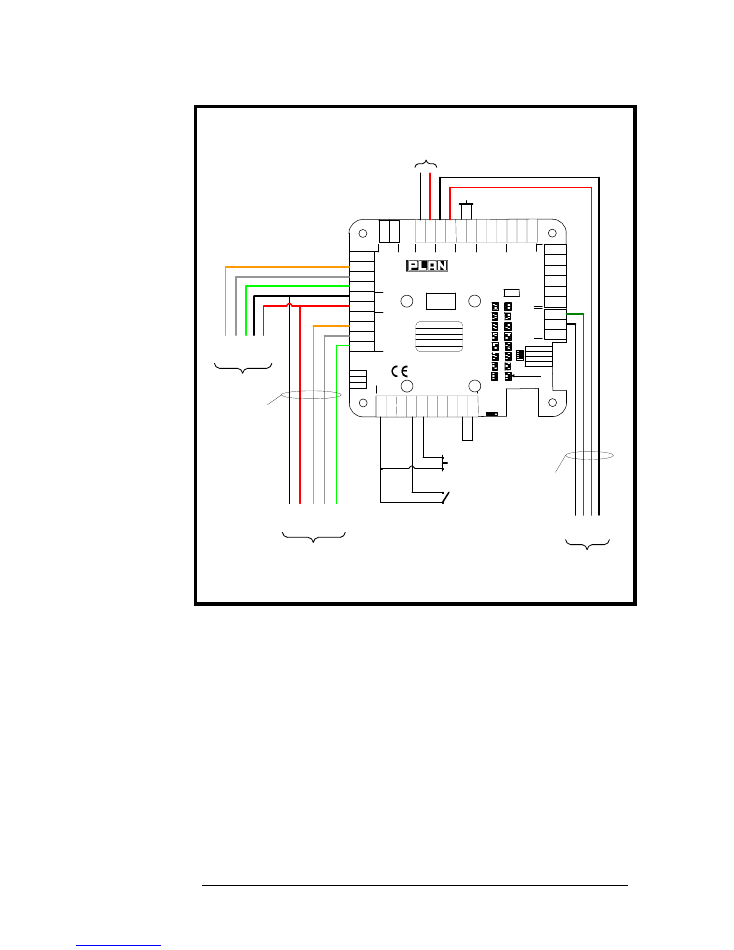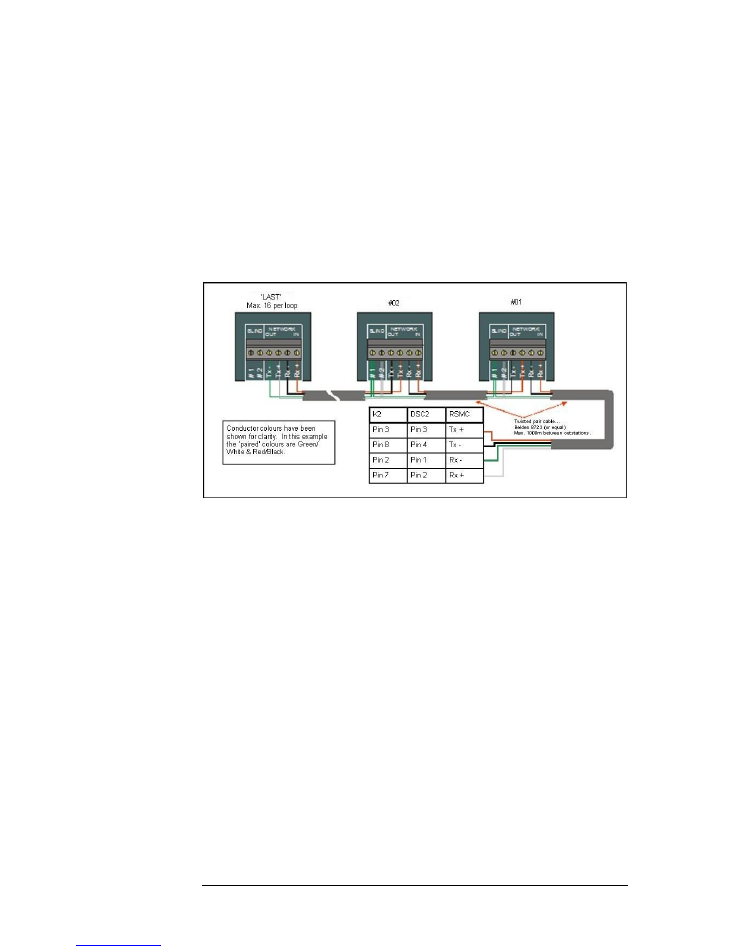Full Text Searchable PDF User Manual

XP1M
V1.0X
Networked Access Control Panel
Installation Guide

i
X P 1 M A C C E S S C O N T R O L S Y S T E M
Installation Guide
Document Ref: PLAN XP1M Installation Guide V4(G)2010
Access Control Services Limited
20-26 High Street, Greenhithe, Kent. DA9 9NN
Phone 01322 370777 • Fax 01322 370076
www.xplan.com
email: support@xplan.com
LIMITED WARRANTY.
i) Access Control Services Limited (ACS) warrants that, if properly installed and correctly operated in conjunction with compatible peripheral equipment and
software (running on a computer for which it was designed) the xP1M control panel will perform substantially in accordance with the accompanying
documentation for a period of five (5) years from the date of purchase from ACS.
ii) Due to the inherently complex nature of computer software and firmware, ACS does not warrant that the panel firmware, PC software or the
documentation is error free, will operate without interruptions, be compatible with all equipment and software configurations, or will otherwise meet your
needs.
iii) Your sole remedy and Access Control Services entire liability will be, at our discretion, either repair or replacement of the equipment, or return of the
price paid.
All rights reserved. Copyright© Access Control Services Limited, Greenhithe, Kent 2002.
COPYRIGHT
The contents of this manual and the associated PLAN software applications are the property of Access Control Services Limited and are copyrighted. Any
reproduction in whole, or part, is strictly prohibited.
The manufacturer observes a policy of continuous product development and reserves the right to alter or change any aspect of the system specification or
documentation without notice.

i
Table of Contents
Introduction __________________ 2
General Description ____________ 3
Product Overview ______________ 3
Technical Specification _________ 4
Features summary _____________ 4
Installation Procedure __________ 5
XP1M Control Panel location ____ 5
Mounting _____________________ 5
Connecting up _________________ 5
Mains Power ____________________ 5
Standby Batteries _________________ 6
External 12vDC Power ____________ 6
Readers ________________________ 6
Door Egress Switch (DR input) ______ 7
Door Monitoring Alarm (MC Input) __ 8
Locks __________________________ 8
Extended Alarms _________________ 9
Fire Alarm override _______________ 9
Networking _____________________ 9
Commissioning Procedure _____ 11
Powering up the unit __________ 11
Setting the station ID __________ 11

X P 1 M I N S T A L L E R G U I D E
2
Introduction
Introduction to the scope of this document and conventions used
throughout the manual.
his manual assumes very little understanding of PLAN access control
systems specifically, however, some aspects of the panel installation
and commissioning process (such as mains connection, lock and reader
termination and PC networking) will require a degree of experience in
security systems installation and a basic knowledge of computers and the
Microsoft Windows operating system.
Note: This guide is not intended to be a definitive installation manual for
installing access control systems. The installer is expected to have a
level of installation expertise and experience appropriate to the scale and
complexity of the project at hand.
At all times the prevailing local safety regulations and codes of practice
should take precedence and be applied to the installation of this system.
This document is intended for guidance on the installation and commissioning
of the X
P1M Access Control Door controller
only. The manual is intended
for installation personnel, project managers and people with similar
responsibilities.
For speed and ease of understanding the XP1M will be referred to in this
document as the ‘System’, and the engineering personnel who carry out the
installation of the system will be referred to as ‘installers’ or ‘users’.
The XP1M is expected to operate as part of an on-line system - connected to a
PC running appropriate PLAN software. For detailed guidance on the use and
operation of the the Software, please consult the relevant user manual (supplied
separately).
T
Note:
Tips, notes, or
definitions are occasionally
printed in the left-hand
margin (like this). These
provide
additional
information which is related
to the subject being discussed
in the main text.

X P 1 M I N S T A L L E R G U I D E
3
General Description
Product Overview
The XP1M controller is designed to be a flexible 1 door access control system,
capable of standalone or networked operation. The system can control up to
50,000 personnel (expandable), has 128 time profiles and alarm monitoring
options with separate alarm output relays.
Each unit features 3 extended alarm inputs for monitoring third party
equipment and standard alarm input devices (such as door contacts and PIRs).
The built in real time clock and system memory are both battery backed on the
circuit board and using the built-in PSU charger option (if fitted) all systems are
also backed up against mains failure. Mains supplies are filtered and suppressed
to protect against spurious noise and surges.
When off-line from the main PC, events are logged in the system RAM and the
last 2000 transactions will be buffered until they can be up-loaded to the host
system when comms is restored.
The XP1M controller is housed in a steel cabinet with provision for cable entry
through the rear panel or side walls. All external connections to the main board
utilise demountable terminal blocks.
The system is compatible with most types of card reader; technologies
supported range from Mag-stripe, Wiegand Swipe and Proximity through to
the more sophisticated Biometric and Contactless Smart Card solutions. The
controller has built-in enhanced support for the latest in multiple-reading long
range RFID tagging.

X P 1 M I N S T A L L E R G U I D E
4
Technical Specification
Enclosure
Construction
Powder coated steel cabinet
Dimensions
320 x 260 x 95mm (H x W x D)
Weight
3.20 Kg
Power
Input
100
– 250v ~ 2.3A 50/60/440 Hz or DC 120-300v 1.5A
Output
Integral 12vDC PSU/Charger unit fused @ 3.15 Amps
Environmental
Operating Temp
0
o
C to +40
o
C
Storage
-10
o
C to +50
o
C
Humidity
10% to 80% (non-condensing relative humidity)
Interfaces
Communications
RS422/RS485/TCP-IP** WiFi*
Reader Interface
Wiegand or ‘Clock and Data’
Protection
Isolated communication, over voltage protection and
transient suppression on all inputs.
* Using appropriate plug-in module.
Features summary
2 card reader inputs (with RTE and Alarm Monitoring facility)
3 extended alarm inputs
50,000 Card holders *
2,000 Event Cyclical Transaction Memory
Fire Alarm override input (jumper configurable)
128 Time Profiles
Shut-down profiles
AES 128 bit encrypted communications
1 x General alarm relay output
Built-in PSU charger Option
TCP/IP LAN and WiFi wireless communications option
* Cardholder capacity may vary depending on card format configuration

X P 1 M I N S T A L L E R G U I D E
5
Installation Procedure
XP1M Control Panel location
The control panel is supplied in a wall mounting enclosure. Care should be
taken to ensure that the mounting surface and the fixings used are appropriate
for the weight of the panel. The following additional notes and observations
should be considered when choosing a location for the unit.
1)
The unit is not designed to be mounted externally unless it is fitted within
a suitably rated secondary enclosure.
2)
Sufficient free space around the unit (approx 35mm) should be left clear
for the purpose of removing the outer doors.
3)
The unit must be fitted in an upright orientation (hinges to the left).
4)
Do not use the XP1M enclosure to house additional equipment (other
than devices specifically designed to be fitted inside the box).
The unit should always be mounted in an accessible location - ideally on the
secure side of the doors that are controlled by the panel.
Mounting
Remove and retain all packaging and documentation that was shipped with the
unit. The precise fixing methods will vary from application to application,
however, as a general guide…
1)
Before fitting the back-box to the wall, establish the preferred route for
cable access into the enclosure; the box is supplied with a number of
25mm holes to the rear and several 20mm ‘knock-out’ access points to
the top, bottom and side walls. Use a hammer and punch to remove
any of ‘knock-outs’ and drill any additional holes that are required
before fixing the box to the wall.
2)
There are four fixing holes in the rear of the enclosure. If necessary,
use the back-box as a template to mark the fixing holes on the wall -
note that the top two fixings are ‘key-holed’ to enable easier single
handed installation.
Connecting up
Mains Power
The XP1M controller unit can be supplied with an integral 13.8vDC
PSU/charger. This unit is fitted into the rear of the back-box and must be
powered from a continuous mains supply. Ideally the mains supply will be
isolated through a dedicated un-switched, fused spur. The length and type of
cable that is used to connect the charger unit to the mains supply should
Note:
Always install at
least one manual access
override if a controller is
located within an area that
has no other means of entry
(i.e other than through a
controlled door).

X P 1 M I N S T A L L E R G U I D E
6
conform to local regulations and be appropriate to the termination method
used in the XP1M (e.g. Fused screw terminal block).
The controller should be earthed and the mains (L&N) polarity should be
observed when making this connection.
Do not apply mains power to the
unit until the readers and other peripheral equipment are fully installed
and connected.
Please see the technical specification indicated on the PSU for further
information about the mains supply voltage and frequency.
Standby Batteries
Space is available inside the enclosure for a single 7Amp/Hr. sealed lead acid
battery, this must be connected to the ‘BATT’ output on the PSU/Charger
(observing the correct polarity). One set of standard battery leads is provided
with each panel – although an additional pair will be provided on request.
Do
not connect the batteries to the unit until the readers and other
peripheral equipment are fully installed and connected.
External 12vDC Power
The control unit can optionally be powered by an external third party 12vDC
PSU. Please see the connection diagrams for further information.
Readers
The system is compatible with most types of card reader; technologies
supported range from Mag-stripe, Wiegand Swipe and Proximity through to
more sophisticated Biometric and Contact-less Smart Card solutions. For
Asset Matching and Long range hands free, the system utilises the latest in long
range RFID tagging.
For connection purposes, all of the above reader options can be split into two
general interface types: ‘Wiegand’ and ‘Clock and Data’. Generally, the
Wiegand interface is used for all proximity readers and ‘Clock and Data’ is used
for Mag-stripe devices.
The documentation provided with the readers should be consulted for
installation guidance and cable requirements, however, the diagram below
indicates how the most common types of reader should be connected into the
XP1M reader ports.

X P 1 M I N S T A L L E R G U I D E
7
S T A N D A R D W I E G A N D R E A D E R T E R M I N A T I O N
RX+
RX-
TX+
TX-
2#
1#
A (A+)
B (A-)
GND
L2 RED
L1 GRN
D1/CLK
D0/DATA
- 0V
+ 12V
L2 RED
L1 GRN
D1/CLK
D0/DATA
G
N
D
R
D
_
T
A
U
X
1
T
a
m
p
A
U
X
2
M
C
D
R
S
E
C
P
R
I
G
N
D
S
ta
ti
o
n
I
D
Fire alarm shunt
5V
RX
TX
C
O
M
N
O
N
C
C
O
M
N
O
N
C
F
A
R
T
N
1
2
V
+
G
N
D
1
2
V
+
G
N
D
Program Socket
CM/RS422
SW 3
SW 2
SW 1
Lock
Relay
Alarm
Relay
Master
Reader
Slave
Reader
Fire
Alarm
Power
In
Power
Out
Network
RS422
Subnet
RS485
Reader
Power
0
9
1
0
1
1
1
2
1
3
1
4
1
5
1
6
o
n
1
2
3
4
Program
A
U
X
3
A
U
X
4
XP1M
AUX
www.xplan.com
Com’s Module
0
1
0
2
0
3
0
4
0
5
0
6
0
7
0
8
Designed and built in the UK
Access Control Services LTD
SW2 SW3 Speed
ON ON 1200
OFF ON 4800
ON OFF 9600
OFF OFF 57600
Cable Spec. Belden 9536
(Max Run 100m)
Tamper Link
(N/C) Monitoring Circuit
(N/0) Exit Button
Master Reader
D
A
T
A
0
D
A
T
A
1
G
R
N
L
E
D
1
2
v
0
v
Cable Spec.
Screened Twisted Pair
Belden 9502
(Max Run 100m)
B
A
1
2
V
G
N
D
Message Display
Unit
Slave Reader
D
A
T
A
0
D
A
T
A
1
G
R
N
L
E
D
1
2
v
0
v
+
-
12v DC @ 2A
A
la
rm
P
o
in
t 1
*
A
la
rm
P
o
in
t 2
*
A
la
rm
P
o
in
t 3
*
A
u
x
in
p
u
t 2
A
u
x
in
p
u
t 1
N/C
Door Control
Relay Output
(max. 1.25A)
Door Egress Switch (DR input)
As can be seen in the diagram above, an input (DR) is provided on each reader
port for a normally open ‘momentary operation’ egress switch. Whenever the
DR (Door Release) input is pulsed low (via the RTE switch) the lock output
will be switched for the pre-selected lock delay time.
The RTE is generally used in the following circumstances…
to provide an exit signal in the case of alarmed doors.
to allow a means of exit for doors with no mechanical override (e.g.
Mag-locks).
to allow the location of a remote override button.

X P 1 M I N S T A L L E R G U I D E
8
to provide an interface point between third party systems (such as
required by telephone entry systems).
Door Monitoring Alarm (MC Input)
Using the MC input, the system can monitor for Door Forced or Door Ajar
alarms.
Door Forced:
If the MC input is open circuit without there first having been a
valid card or RTE, then a Door Forced alarm will be generated.
Door Ajar:
If the MC input remains open circuit for longer than the allocated
door ajar delay then a Door Ajar alarm will be generated.
To use the door monitoring feature, connect a normally closed alarm circuit
between MC and 0V (this input would usually be derived from an integrated
contact within the locking device).
Note:
In addition to the door state monitoring for reader controlled doors, the
System features an additional 3 extended alarm inputs… please see ‘Extended
Alarms’ for more information.
Locks
The XP1M provides the installer with a volt free SPCO relay o/p for
connection of locking devices or third party control equipment (such as vehicle
barriers or powered doors).
For locking devices that draw up to 1.25 Amps, the lock feed can be switched
directly by the relay o/p. For locks that draw above 500mA, the source power
should not be drawn from the 'on-board' XP1M 12v power, but direct from
the PSU fitted in the rear of the enclosure - or from an additional PSU fitted
adjacent to the controller.
An optional ‘Break-Glass’ fire alarm override switch can be fitted in such a way
that it breaks either the positive, or, depending on local codes of practice, both
poles.
Under no circumstances should the emergency override be
installed so that it is only switching the negative supply.
The Break Glass device would normally be required if the controlled door
prevented access or egress to a nominated Fire Exit.
Please note that some
local authorities will require the use of a Double Pole break glass call
point (configured to disconnect power to both poles of the locking
device).
It is advisable to separately fuse the individual lock feeds using 'in-line' fuses as
shown.
The specific arrangement and connection of the locking device will be
dependent on the type of equipment used. In all cases reference and

X P 1 M I N S T A L L E R G U I D E
9
consideration should be made to the lock supplier’s documentation before
connection.
IMPORTANT NOTE:
For enhanced safety and flexibility the XP1M
controller firmware features the option to select Fail Safe or Fail Secure mode
from within the software. When set into Fail Safe mode the selected lock relays
will reverse their operation. This should be taken into consideration when
connecting a Fail Safe locking device because the panel default is for Fail
Secure.
Extended Alarms
Each XP1M features 3 extended alarm inputs for monitoring third party
equipment and standard alarm input devices (such as door contacts and PIRs).
Fire Alarm override
In addition to the local Break Glass Points fitted at each door, the System
can accept door override signals from a Fire Alarm system using the
configurable Fire Alarm Input.
At all times, this input must detect a closed contact ‘
safe
’ signal from an
evacuate relay controlled by the fire alarm system. If the fire alarm link is
removed, or the fire panel is activated, the selected doors will open.
The doors that will open in the event of an evacuation signal are selected
by means of a jumper (JP1) as shown above.
NOTE:
The Fire Alarm override input will only activate doors that have
been set to Fail Safe in the door configuration menu.
Since this facility does not depend on the microprocessor to operate it can
be considered fail safe in operation.
Networking
The PLAN system offers the installer a high degree of networking flexibility.
Direct cabled ‘star’ and ‘daisy chain’ topologies can be used. Using the field
upgradeable plug-in Ethernet module, client LAN/WAN infrastructure can be
utilised, as well as a wireless Ethernet (WiFi) option. All of these can be mixed
in a single installation.
As standard, the panel is shipped with the relevant jumpers set for direct cabled
systems, this presumes that XP1Ms are linked together using dedicated twisted
paired cables and connected to the Host PC via an RS422 interface.
Network cable should be minimum 7/0.2mm shielded two twisted
pairs. Recommended cable is Belden 8723 or equivalent. Maximum
cable distance between any two panels is 5,000m.

X P 1 M I N S T A L L E R G U I D E
10
Normal precautions to avoid possible causes of harmful interference
should be employed… e.g. avoid running with heavy duty mains cables
or adjacent to fluorescent lighting etc.
A maximum of 16 door controllers (XP1Ms PLAN200s or
PLAN400s) can be connected to any single comms port.
Care should be employed when using twisted pair cables that include
multiple ‘black’ conductors. ‘Crossing’ the black conductors between
panels will cause spurious faults that may be difficult to track down.
P L A N N E T W O R K C O N N E C T I O N D I A G R A M
Note above that the ‘BLIND’ terminals have been used to link the ‘through’
pair in the IN and OUT cables. These termination points have no connection
to the panel electronics and are provided solely for the purpose of linking the
‘straight-through’ pairs. The Blind terminals are not used in controllers situated
at the end of a chain.

X P 1 M I N S T A L L E R G U I D E
11
Commissioning Procedure
Powering up the unit
Before applying mains power to the XP1M, make a final check that all
connections are made off and terminated correctly. It is important that these
checks are carried out at the panel
and
at the door location. Ensure that all
unused conductors and foil shielding is insulated and made ‘safe’ as necessary
to prevent short circuits when the panel is closed.
To initiate the first time power-up sequence apply mains power to the
PSU/charger. Check that the LED on the PSU is displaying Green and that
the “5vDC” and LED on the xP1M is illuminated. If the LEDs are on,
connect the stand-by batteries to the PSU charger.
For direct cabled applications ensure that the ‘Comms Select’ jumpers are set
for RS422. For alternate communications configurations such as WiFi or
Ethernet, please refer to the relevant paperwork.
Setting the station ID
If the XP1M is connected in a network to other PLAN400s or PLAN200s,
then each unit must be given a Station-ID in the range 01-16. To Set the
Station ID for this panel simply use the dip switches as indicated on the PCB
overlay.
The control panel is now ready to be tested on-line. Refer to the
software manual for further instruction.